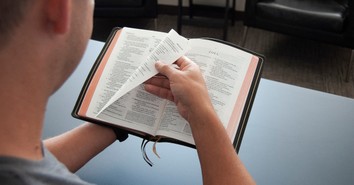Bible Translations

The differences between translations have more to do with reading level and style than with content. Some translations specifically target younger readers and so limit the vocabulary and difficulty of grammatical structures.
Another factor accounting for differences is translation theory. A translation theory addresses the question of how best to translate ideas from the original language (Hebrew or Greek) in the receptor language (English). Some translators use the formal correspondence approach, translating word for word, even if doing that causes awkward sentences. Other translators use the dynamic equivilence approach and translate thought for thought as they attempt to produce in the modern reader the same effect that the Scripture is likely to have had on the original reader. Most translations are somewhere on the continuum between these two approaches.
English readers are fortunate to have more than 75 different Bible translations to choose from. Many people don't have the Bible in their own language.
Here are some comments on the more popular translations.
New International Version (NIV - 1979) The NIV is the favorite of many evangelical Christians. You need only an 8th grade level of reading to understand the NIV. It reads more smoothly than most translations and scholars praise it for its accuracy. It was put together by a large team of well recognized Bible scholars. Another plus: it will probably be around awhile so you're safe to memorize in it.
For the beginner, I also recommend the Living Bible (1972 - The Way, The Book and many other editions). Technically, it's a paraphrase, not a translation. It's not translated from the original Hebrew and Greek languages. Ken Taylor wrote it to put the Bible in words that his kids would understand. This book has been used by God to bring thousands of people to Himself. The drawback is that it is the interpretation and explanation of one man and therefore can be more subject to error. It's not the best for serious Bible study.
Another in this category that many people like is the J.B. Phillips paraphrase ( The New Testament in Modern English - 1958 ). The latest paraphrase is The Message by Eugene Peterson, a Presbyterian pastor and an excellent writer. It's great for reading. In fact, it's arranged for that purpose; there are no verse markings. Peterson takes great liberties with words in his attempt to effectively communicate the thoughts of Scripture (Dynamic Equivilence).
The King James Version (KJV - 1611), also known as the Authorized Version (AV), has been a standard for centuries and is loved and revered around the world. But language has changed a lot since 1611, words often don't mean the same thing today. The KJV is a literary masterpiece but it's tough to read. It's also a little less accurate than modern translations which have the benefit of many recent archaeological and manuscript discoveries, like the Dead Sea Scrolls. The New King James Version (NKJV - 1982) attempts to update the language without alienating its loyal and sometimes demanding readers.
The Revised Standard Version (RSV - 1952) is what you'll find in the pew pockets of most Presbyterian churches. A standard in many church denominations, the RSV is given an "A" for accuracy by most scholars. The RSV alienated many evangelicals for the way it translated Isaiah 7:14: "Therefore the Lord himself will give you a sign. Look, the young woman is with child and shall bear a son, and shall name him Immanuel." Evangelicals and fundamentalists contend that the text should read "virgin," not "young woman." It's not as easy to read as the NIV because it hangs on to a lot of the KJV "holy language" ("thee"s and "thou"s).
But, once again, modern translators have come to the rescue with the New Revised Standard Version (NRSV - 1989) to produce a translation that is accurate and much easier to read. One NRSV distinctive is that it is "gender inclusive," meaning the translators have replaced "men" or male pronouns with "people" or inclusive pronouns ("you") when original writers meant both men and women. For example, the NRSV translates John 11:25, "Jesus said to her, "I am the resurrection and the life. Those who believe in me, even though they die, will live." The KJV and NIV translate more literally, "he who believes..." The NRSV does not change masculine pronouns referring to God, however.
The New American Standard Bible (NASB--1971) was produced by a team of scholars sponsored by the Lockman Foundation as a revision of the American Standard Version (1901). Their intent was to produce a literal translation of the Bible that would bring the contemporary reader as close as possible to the actual wording and grammatical structure of the original writers. The NASB is a classic example of formal correspondence theory of translation and is a good choice for in-depth Bible study. The downside to such reverence for the original language is, at times, difficult reading in the receptor language.
Bibles For Kids
Most Bible translations are also available in Children's editions. That means the same text as adult Bibles with perhaps larger print and pictures added. However, the International Children's Bible, New Century Version (NCV - 1988) is an excellent translation geared for children with no more than a third-grade reading level. It comes with colorful pictures and charts. The NCV is also a good choice for someone who speaks English as a second language.
For younger kids, try Family Time Bible Stories (written by Anne de Graaf, illustrated by Jose Perez Montero, Zondervan Publishers, 1987). It comes in six child-size volumes that include great pictures and very simple language. Each story is bedtime-story length. For toddlers, there is My First Bible in Pictures by Kenneth Taylor (who wrote the Living Bible) with great illustrations by Richard and Frances Hook.
Sample Translation Comparison:
Compare how different translations handle this verse, Romans 5:8:
New International Version (NIV - 1979): "But God demonstrates his own love for us in this: While we were still sinners, Christ died for us."
Living Bible (LB - 1972): "But God showed his great love for us by sending Christ to die for us while we were still sinners."
The Message (NavPress, 1993): "But God put his love on the line for us by offering his Son in sacrificial death while we were of no use whatever to him."
King James Version (KJV - 1611): "But God commendeth his love toward us, in that, while we were yet sinners, Christ died for us."
New King James Version (NKJV - 1982): "But God demonstrates His own love toward us, in that while we were still sinners, Christ died for us."
New Revised Standard Version (NRSV - 1989): "But God proves his love for us in that while we still were sinners Christ died for us."
International Children's Bible, New Century Version (ICB - 1988): "But Christ died for us while we were still sinners. In this way God shows his great love for us."
A good suggestion for Bible study would be to read from several translations at the same time. You can get books or Bible software for computer that contain several popular translations side by side.
Study Bibles (NIV, Thompson Chain Reference, Ryrie, Harper's, Lindsell, etc.):
America's best-selling study Bible is the NIV (New International Version) Study Bible. It comes highly recommended by people in the know. It has 20,000 footnotes which elaborate on the meaning of tough verses, 100,000 biblical cross-references, 80 charts and maps, an index and a concordance. (Prices start at about $35, hardcover, more for leather bound.)
A Bible For Rush Hour:
The entire Bible is available on cassette tapes but it's usually expensive. However, here's a deal I ran across a few years ag the New Testament on twelve cassettes for the unbelievable price of $22.00 ($84 for the whole Bible). You can order either KJV or NIV. Call Hosanna, toll-free, 1-800-545-6552 or write at 2421 Aztec Road NE, Albuquerque, NM 87107-4224. Now, you can listen to the Bible while jogging, driving, cooking, etc.
Originally published September 05, 2008.







